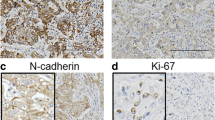Abstract
Background/Aims
Epithelial-mesenchymal transition (EMT) plays an important role in hepatocellular carcinoma (HCC) dissemination. Bromodomain PHD-finger transcription factor (BPTF) could regulate embrogenesis and stem cell differentiation, and it may be involved in tumor progression and EMT. In this study, we aimed to determine BPTF, E-cadherin and vimentin expression in tumor tissues and the clinical significance in relation to HCC.
Methods
The BPTF, vimentin and E-cadherin expression of 106 HCC tissue samples was examined by immunohistochemical staining.
Results
BPTF and vimentin showed high expression and E-cadherin showed low expression in HCC. BPTF is associated with the tumor number, vascular invasion, Edmondson-Steiner grade, TNM stage and recurrence (P < 0.05). Vimentin is positively correlated with tumor size, tumor number, vascular invasion, Edmondson-Steiner grade, TNM stage and recurrence (P < 0.05). E-cadherin is negatively correlated with tumor number, Edmondson-Steiner grade, TNM stage and recurrence (P < 0.05). Survival analysis has shown that high expression of BPTF and vimentin indicates poorer overall and disease-free survival (P < 0.05). Multivariate analysis shows that BPTF is an independent marker for survival prediction (P = 0.015). Additionally, high BPTF expression is correlated with high vimentin expression and low E-cadherin expression (P < 0.05).
Conclusion
High BPTF expression may be an independent marker for survival prediction in HCC patients and is probably involved in EMT.



Similar content being viewed by others
References
Jemal A, Bray F, Center MM, Ferlay J, Ward E, Forman D. Global cancer statistics. CA Cancer J Clin. 2011;61:69–90.
de Lope CR, Tremosini S, Forner A, Reig M, Bruix J. Management of HCC. J Hepatol. 2012;56:S75–S87.
Wysocka J, Swigut T, Xiao H, et al. A PHD finger of NURF couples histone H3 lysine 4 trimethylation with chromatin remodelling. Nature. 2006;442:86–90.
Jones MH, Hamana N, Shimane M. Identification and characterization of BPTF, a novel bromodomain transcription factor. Genomics. 2000;63:35–39.
Jordan-Sciutto KL, Dragich JM, Caltagarone J, Hall DJ, Bowser R. Fetal Alz-50 clone 1 (FAC1) protein interacts with the Myc-associated zinc finger protein (ZF87/MAZ) and alters its transcriptional activity. Biochemistry. 2000;39:3206–3215.
Li H, Ilin S, Wang W, et al. Molecular basis for site-specific read-out of histone H3K4me3 by the BPTF PHD finger of NURF. Nature. 2006;442:91–95.
Landry J, Sharov AA, Piao Y, et al. Essential role of chromatin remodeling protein Bptf in early mouse embryos and embryonic stem cells. PLoS Genet. 2008;4:e1000241.
Goller T, Vauti F, Ramasamy S, Arnold HH. Transcriptional regulator BPTF/FAC1 is essential for trophoblast differentiation during early mouse development. Mol Cell Biol. 2008;28:6819–6827.
Buganim Y, Goldstein I, Lipson D, et al. A novel translocation breakpoint within the BPTF gene is associated with a pre-malignant phenotype. PLoS ONE. 2010;5:e9657.
Kim K, Punj V, Choi J, et al., Gene dysregulation by histone variant H2A.Z in bladder cancer. Epigenetics Chromatin. 2013;6:34.
Xiao F, Kim YC, Snyder C, et al. Genome instability in blood cells of a BRCA1+ breast cancer family. BMC Cancer. 2014;14:342.
Kalluri R, Weinberg RA. The basics of epithelial-mesenchymal transition. J Clin Invest. 2009;119:1420–1428.
Craene BD, Berx G. Regulatory networks defining EMT during cancer initiation and progression. Nat Rev Cancer. 2012;13:97–110.
Fan CC, Wang TY, Cheng YA, et al. Expression of E-cadherin, Twist, and p53 and their prognostic value in patients with oral squamous cell carcinoma. J Cancer Res Clin Oncol. 2013;139:1735–1744.
Mulder KW, Wang X, Escriu C, et al. Diverse epigenetic strategies interact to control epidermal differentiation. Nat Cell Biol. 2012;14:753–763.
Dai X, Deng S, Wang T, et al. Associations between 25 lung cancer risk-related SNPs and polycyclic aromatic hydrocarbon-induced genetic damage in coke oven workers. Cancer Epidemiol Biomarkers Prev. 2014;23:986–996.
Lim J, Thiery JP. Epithelial-mesenchymal transitions: insights from development. Development. 2012;139:3471–3486.
Maheswaran T, Rushbrook SM. Epithelial-mesenchymal transition and the liver: role in hepatocellular carcinoma and liver fibrosis. J Gastroenterol Hepatol. 2012;27:418–420.
Choi SS, Diehl AM. Epithelial-to-mesenchymal transitions in the liver. Hepatology. 2009;50:2007–2013.
Thiery JP, Acloque H, Huang RY, Nieto MA. Epithelial-mesenchymal transitions in development and disease. Cell. 2009;139:871–890.
Acknowledgments
The authors thank Fan Zheng for polishing the English in the revision.
Conflicts of interest
There are no conflicts of interest.
Author information
Authors and Affiliations
Corresponding author
Rights and permissions
About this article
Cite this article
Xiao, S., Liu, L., Fang, M. et al. BPTF Associated with EMT Indicates Negative Prognosis in Patients with Hepatocellular Carcinoma. Dig Dis Sci 60, 910–918 (2015). https://doi.org/10.1007/s10620-014-3411-0
Received:
Accepted:
Published:
Issue Date:
DOI: https://doi.org/10.1007/s10620-014-3411-0




